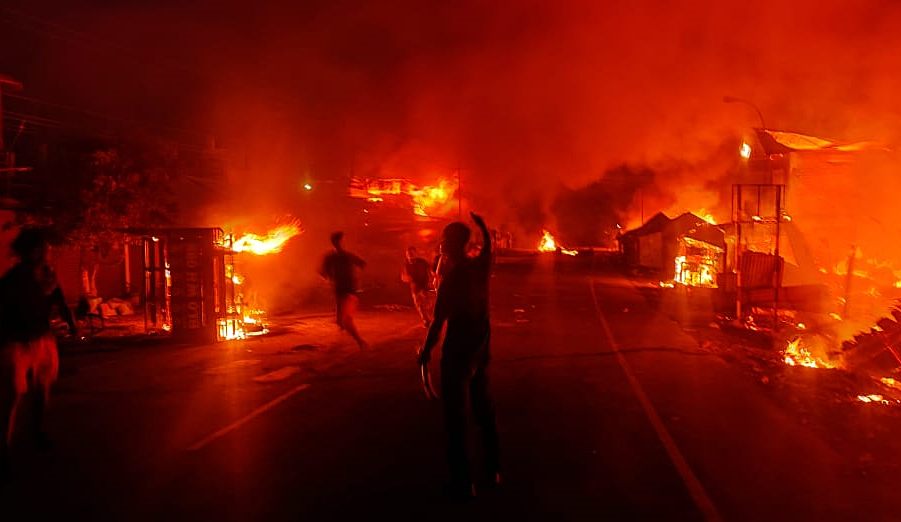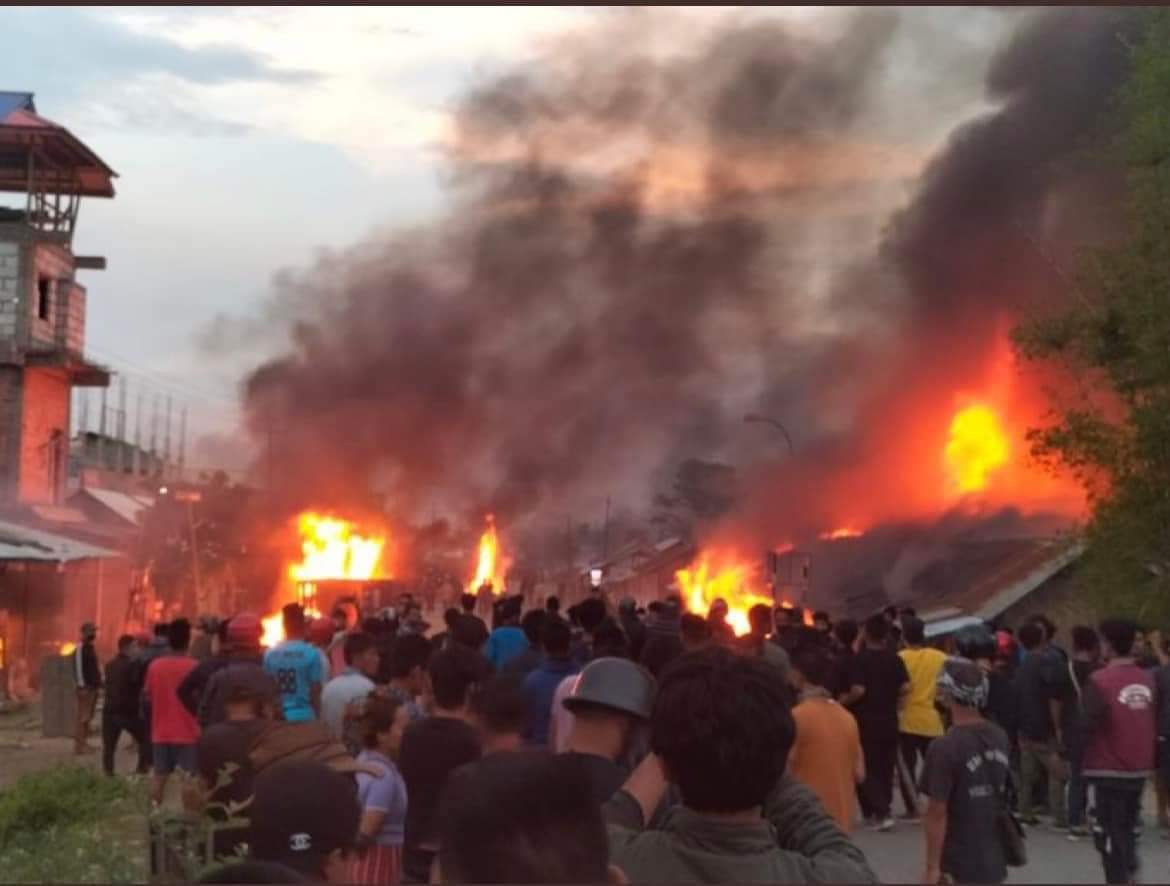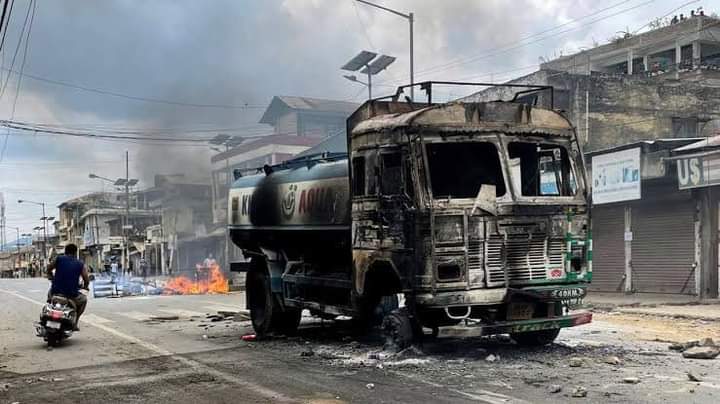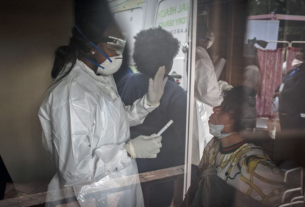Sun 07 May 2023:
Tribal groups are protesting the prospect of Manipur’s majority Meitei community being recognised as a “Scheduled Tribe”.
At least 54 people have reportedly been killed and some 23,000 people displaced, most of them sheltering in army camps, in ethnic violence in India’s northeastern state of Manipur, according to military officials.
On Sunday, the army said it had “significantly enhanced” its surveillance in violence-affected areas, including the Imphal Valley, through aerial means such as drones and the deployment of military helicopters.
The unrest in Manipur state erupted on Wednesday after a protest march organised by the Kuki tribal group sparked clashes with the Meitei non-tribal group, resulting in widespread damage to vehicles and properties.
Authorities on Thursday issued “shoot-at-sight” orders and called military reinforcement to quell the violence that opened a new faultline in the state with a checkered history of ethnic violence. Internet connection was cut off after violence broke out on Wednesday and a curfew was imposed in nine out of the 16 districts.
On Sunday, the army said that there was no new “major violence” overnight and that a curfew was lifted between 7am and 10am (02:00 and 05:00 GMT) in the Churachandpur district, one of the main flashpoint areas.
Authorities have not given an official death toll, but hospital morgues in the state capital Imphal and in Churachandpur had reported a combined total of 54 dead, according to local media.
Meitei community: The dominant largely Hindu community, which is based in the state’s capital city of Imphal, forms more than 50 percent of the state’s population of 3.5 million, as per India’s last census in 2011.
While the Meiteis are mostly based in the plains, they have a presence in the hills as well.
The Naga and Kuki tribes: The two mostly Christian tribes form around 40 percent of the state’s population, and enjoy “Scheduled Tribe” status, which gives them land-owning rights in the hills and forests. They are the most significant tribes residing in the hills.
Other tribal groups, including the Mizo, also constitute the diverse ethnic makeup of the state, which borders Myanmar.
What is a “Scheduled Tribe”?
Constitutionally recognised, this official designation gives certain protections to tribes and communities.
“The Meiteis claim they are marginalised as compared to the other mainstream communities,” he said.
How did violent clashes start?
Violence erupted in the Kuki-dominated Churachandpur district of the state, where members of the Kuki tribe were protesting against the Meitei community’s demands to be designated as a “Scheduled Tribe”.
“The tribes believe granting “Scheduled Tribe” status to the Meiteis would be an infringement of their rights as they claim to be the marginalised part of the population, and not the Meiteis,” Saikia told Al Jazeera.
Why are the tribes protesting?
According to Saikia, the tribes believe the Meiteis are already a dominant community and “call the shots in state politics” and hence should not be given affirmative action.
“They see it [Scheduled Tribe status] as the Meiteis eating into their pie,” he said.
What’s the historical background of the violence?
Both sides have a long history of violent clashes and deep-running ethnic tensions.
“There have been deep-rooted long-running tensions between the hill and the valley and there were conflagrations in 2015 for different reasons, but the same underlying tensions,” said Saikia.
He noted that the violence has historically been ethnic and that while there may be some overlap with religion, it has mostly remained an ethnic conflict with some instances of inter-tribe violence as well.
“There has been violence in Manipur since its incorporation into the Indian state. It is a complicated, complex region shaped by several factors,” Saikia said.
What is the government’s role since the outbreak of violence?
The state government is run by Prime Minister Narendra Modi’s Bharatiya Janata Party (BJP).
He quoted eye-witness accounts as saying that state police had failed to rein in the mobs and control the clashes in Meitei-dominated Imphal and other parts of the state.
“People from the Kuki community said there had been targeted attacks against them by violent mobs,” Saikia said, but added that there is an “information vacuum” in the area as journalists are unable to enter Churachandpur due to the violence and as internet services have been cut off.
Local media has reported that armed Kuki fighters have waged attacks, taken over the streets and clashed with security forces.
Where do things stand now?
Nearly 23,000 people have been displaced from both sides.
He said the government has sent two security advisers to the state to help establish law and order, but the situation remains tense.
______________________________________________________________
FOLLOW INDEPENDENT PRESS:
TWITTER (CLICK HERE)
https://twitter.com/IpIndependent
FACEBOOK (CLICK HERE)
https://web.facebook.com/ipindependent
Think your friends would be interested? Share this story!







